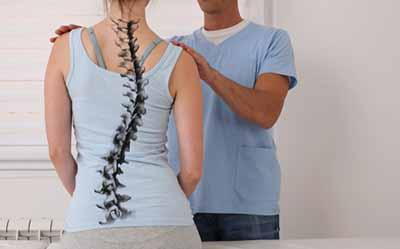Location
Diagnosing Scoliosis: Screening, Imaging, and Assessment Methods

- posted: Jun. 03, 2024
Concerned you or a loved one may be living with scoliosis? Dr. Brian Cesak at Cesak Chiropractic in West Houston, TX, offers assessment, diagnosis, and treatment to suit your needs.
Methods of Diagnosing Scoliosis
Though scoliosis is a common issue, not everyone is aware they have it as they feel no symptoms. However, as it is a spinal deformity, it can worsen and cause various issues, including breathing difficulties when it is severe. As with any other condition, it’s always better to be safe than sorry by being evaluated for the condition. Dr. Cesak and the team at Cesak Chiropractic of West Houston, TX, share the most common evaluation tools and methods of treatment.
Diagnostics Methods
One of the most well-known evaluations is usually done in both middle schools and pediatricians’ offices. It’s known as the Adam’s Forward Bend Test, during which the patient simply leans forward. The evaluator can determine from this angle whether there are any symmetry or curvature issues within the spine.
While the Adam’s Forward Bend Test can be telling, it doesn’t tell all. Radiographic tests provide a more comprehensive look. These include the following.
- X-ray: If you’ve ever broken a bone, you are familiar with X-rays. A picture is taken of the spine with specialized equipment. These images can show a variety of issues, including spinal curvature.
- CT or CAT Scan: These images can show an in-depth look at the spinal canal, including its size and shape.
- MRI: Through the use of a computer and magnets, an MRI provides a three-dimensional image of the body. This provides a good look at the various components of the spinal column, including the nerve roots, to help identify any damage, deformities, or injuries.
Through these various images, a proper diagnosis can be determined. If scoliosis is confirmed, your chiropractor will determine the location of the abnormal curve and the degree of the curvature. Using this information, as well as your age and other factors, a treatment plan can be developed.
How Is Scoliosis Treated?
When the curvature is not severe, treatment will focus on maintaining spinal alignment through adjustments, physical therapy including posture training, and observing the progression of the curve. At times and in those who have not yet finished growing, bracing can help prevent progression. If the curve reaches 40 degrees and is expected to progress, surgery is typically required.
Let Dr. Cesak and the team at Cesak Chiropractic of West Houston, TX, provide you with a proper diagnosis and the most effective scoliosis treatment plan for your needs. Call (281) 589-2225 to schedule an appointment today.

- posted: Jun. 03, 2024
Concerned you or a loved one may be living with scoliosis? Dr. Brian Cesak at Cesak Chiropractic in West Houston, TX, offers assessment, diagnosis, and treatment to suit your needs.
Methods of Diagnosing Scoliosis
Though scoliosis is a common issue, not everyone is aware they have it as they feel no symptoms. However, as it is a spinal deformity, it can worsen and cause various issues, including breathing difficulties when it is severe. As with any other condition, it’s always better to be safe than sorry by being evaluated for the condition. Dr. Cesak and the team at Cesak Chiropractic of West Houston, TX, share the most common evaluation tools and methods of treatment.
Diagnostics Methods
One of the most well-known evaluations is usually done in both middle schools and pediatricians’ offices. It’s known as the Adam’s Forward Bend Test, during which the patient simply leans forward. The evaluator can determine from this angle whether there are any symmetry or curvature issues within the spine.
While the Adam’s Forward Bend Test can be telling, it doesn’t tell all. Radiographic tests provide a more comprehensive look. These include the following.
- X-ray: If you’ve ever broken a bone, you are familiar with X-rays. A picture is taken of the spine with specialized equipment. These images can show a variety of issues, including spinal curvature.
- CT or CAT Scan: These images can show an in-depth look at the spinal canal, including its size and shape.
- MRI: Through the use of a computer and magnets, an MRI provides a three-dimensional image of the body. This provides a good look at the various components of the spinal column, including the nerve roots, to help identify any damage, deformities, or injuries.
Through these various images, a proper diagnosis can be determined. If scoliosis is confirmed, your chiropractor will determine the location of the abnormal curve and the degree of the curvature. Using this information, as well as your age and other factors, a treatment plan can be developed.
How Is Scoliosis Treated?
When the curvature is not severe, treatment will focus on maintaining spinal alignment through adjustments, physical therapy including posture training, and observing the progression of the curve. At times and in those who have not yet finished growing, bracing can help prevent progression. If the curve reaches 40 degrees and is expected to progress, surgery is typically required.
Let Dr. Cesak and the team at Cesak Chiropractic of West Houston, TX, provide you with a proper diagnosis and the most effective scoliosis treatment plan for your needs. Call (281) 589-2225 to schedule an appointment today.
Main Location
14441 Memorial Dr Ste 24 ,
Houston, TX 77079-5234
